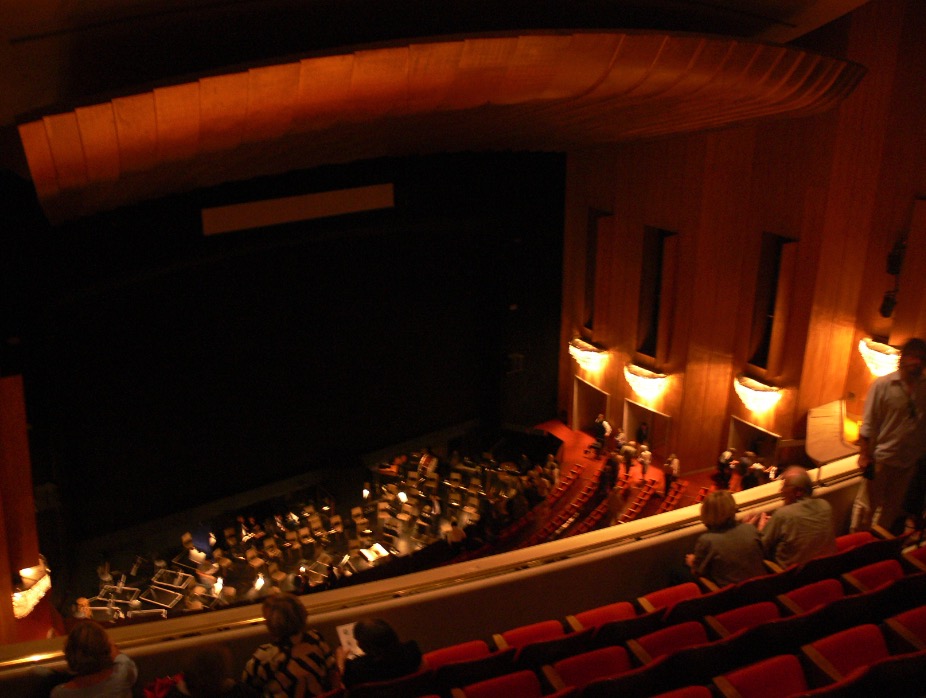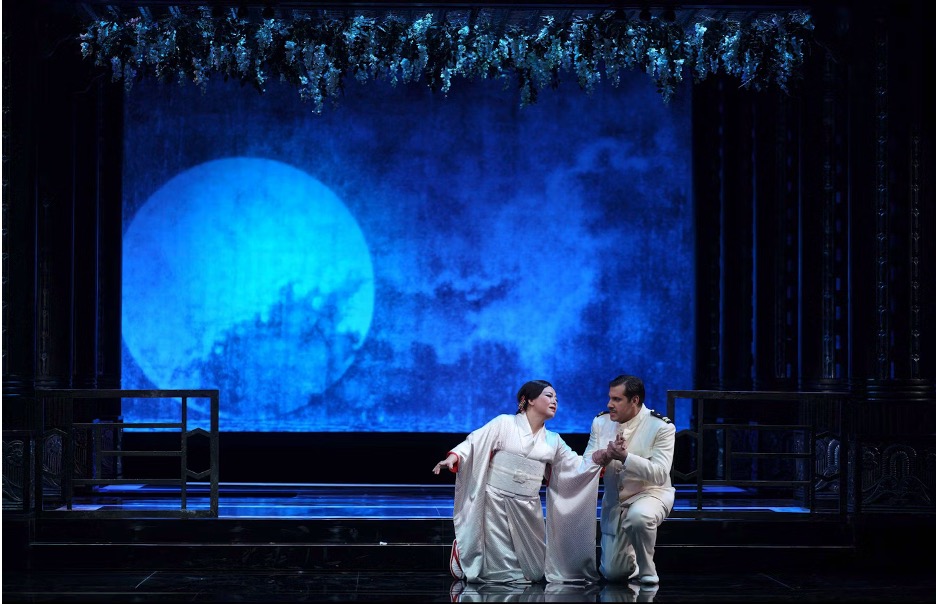Comments
GELFAND’S WORLD - The LA Opera production of Madame Butterfly (one performance left on October 13) is a triumph in all regards. Every role is presented by an accomplished performer, with the role of Butterfly carrying the night. We can get to that further on, but I mainly want to give credit to the remarkable achievement the LAO has managed in merging opera with cinema to take art to what may be the next step.
To make this argument, I'm going to accept the premise that there is something useful and even powerful about a live performance. Otherwise, opera could simply be presented as movies, while using all the cinematographic and editing techniques which already exist. We would then have the movie musical, a fine and accomplished artform of its own. But for some reason, people by the thousands attend live performances. For example, the current production of Madame Butterfly will have reached well over ten thousand live viewers by the time the run is completed. And it turns out that there have been lots of theatrical and movie versions of this story, but the audience for live performance is yet robust.
Just as a taste for Madame Butterfly, allow me to offer you a couple of versions of the aria Un Bel Di, as presented in an Australian production by Karah Son, given here, and by Angela Gheorghiu, given here.
But there is an issue with viewing from the balcony. It's not the sound, particularly the orchestral sound, which isn't a lot different when you compare the balcony and the first floor. Acoustics make it all possible. And the sound of the singers, although a little less strong in the far reaches of the modern opera house is, nevertheless, still strong enough to be heard and to be felt emotionally.

But there is a limitation when it comes to facial expressions. Of course this is also a problem in the live dramatic theater when the auditorium is large enough. You can be just as far from the stage in Death of a Salesman if it is performed in a huge place. Still, it's an issue, and for whatever reason, simple dramatic productions often work better in the movies because we see the characters up close.
Now we come to the current production of Madame Butterfly. What allows Butterfly to stand out is that it legitimately has dramatic elements that would work by themselves, even in the absence of operatic music. In fact, Butterfly began in a novel, was presented as a story and a stage play, and through this route was eventually noticed by Giacomo Puccini, who decided to create an opera based on the story.
In short, the opera Madame Butterfly is a strong drama in and of itself which, in combination with Puccini's musical genius, gifts us with songs that grab us and enthrall us.
Let's consider one element of this drama. The character Butterfly -- actually Cio-Cio-San -- has been wed by an American naval officer, but relies on her servant, a woman referred to as Suzuki. There is a lot of interaction between the two, as you might imagine, and that interaction would be a central element in any movie or stage version. So the movies have this one advantage over opera (and even over staged plays) in that everyone in the audience gets to see the facial expressions of the characters. Of course this is where the difference comes in -- the movies, as close as they get, do not give us the full range and strength of the human voice in the way that live performance does.
There are competing virtues: In the movies, we get the full emotional effect of seeing faces. In opera we get the full emotional power of the sung word.
There have been attempts at hybrid performances, not the least of which are cinematic adaptations of operas. Some few may remember a cinematic rendering of Parsifal which worked to some extent. Another hybrid involves the Metropolitan Opera performances presented as televised presentations in movie theaters. I've seen a couple of them in the AMC theaters in Torrance, and they worked pretty well. They are not the same as a live performance.
Now we come to the current production. We can credit the sets and overall plan to the Teatro Real of Madrid. The modification from the original Puccini opera is simply to put a couple of movie cameras on the side of the opera stage and present Madame Butterfly as though it were an attempt to film the performance on a sound stage, as if it were in the early 1930s. The idea of a play within a play is nothing new (think Hamlet) and in this production the cameras are just there. They don't actually change the plot, and the intrusion is kept to a minimum.

But the existence of the cameras allows for one modification in the way we usually view opera. The modern performance space has allowed for the projection of titles which serve to present a running, simultaneous translation of what is being sung on stage. Even European opera houses use projected titles, or sometimes just provide the audience with small individual viewers. But in this performance, we are presented with a viewing screen which is none other than a movie screen, showing the characters in closeup, just as we might have seen them in a 1920s era movie. In fact, the projected image was in black and white, making it all the more akin to a silent era film.
The result was that we the audience were presented with two different images to go along with the sound -- the one being the live characters on stage, the other being the movie version. And the movie version allowed everyone in the wide spaces of the Music Center Pavilion to see in detail what the characters' faces are showing.
In practice, I mostly watched the movie.
It was not without its limitations. There was that bit of distraction involved in looking back and forth between the live action and the black and white movie version. But the positive side was that the audience was presented with the full emotional power of seeing Butterfly and Suzuki interacting in closeup. The music was married to the drama in a way which would have been impossible to achieve in the absence of some such device.
It's true that we've seen cinematic devices used in other live performances -- most notably in the live broadcasts from the Metropolitan Opera -- but this performance was certainly the most powerful emotionally.
Of course a lot of that emotional appeal comes from Puccini's music. It's the reason that this opera has been popular for 120 years now.
One additional note about casting at LA Opera.
I've noticed that the LAO has been moving away from filling its performance ranks with European singers. It used to be that Italian, French, and Spanish singers were considered to be the true opera singers, while once in a while an American was allowed to intrude. Since the Covid epidemic, we have seen a trend away from that. For a while, the LAO was featuring mostly American-born singers. It turns out that there are quite a few well-trained American artists with marvelous voices who can carry the roles.
Madame Butterfly turns out to be something of an exception, because it has traditionally been the role which allowed Asian-born singers to take the American and European stage. In this performance, Korean born Karah Son as Butterfly and Korean-born Hyona Kim as Suzuki were marvelous. Other Asian singers were Hyungjin Son as Prince Yamadori and Wei Wu (from Beijing) as the Bonze.
We should also take note of the fact that the era in which Madame Butterfly was first performed was certainly a time in which the European and American cultures not only viewed Asian cultures as exotic and distant, the white folks tended to look down on the whole idea of Asians. The program book given out at this opera includes essays explaining that modern opera companies try to play down the racism that originally existed in earlier performances.
I offer a slightly different interpretation, namely that the European context from which this opera arose treated all other parts of the world as inferior to European culture. American culture and geography were treated as weird (The Rise and Fall of the City of Mahagony, Fanciulla del West) just as everything Asian was exotic and perhaps even a little weird (Turandot, Madame Butterfly).
But taken in the entirety, this production, with Karah Son's wonderful interpretation, Puccini's music, and the closeups provided by the movie screen, all combined to provide a more emotionally charged experience than we usually get.
One other point to make: James Conlon has been the chief conductor and music director of LA Opera even as he has carried on an internationally renowned career, including a lot of performances at the Met. He will be moving on in the next year, so this is the moment to catch him if you have not yet done so.
(Bob Gelfand writes on science, culture, and politics for CityWatch. He can be reached at [email protected].)






